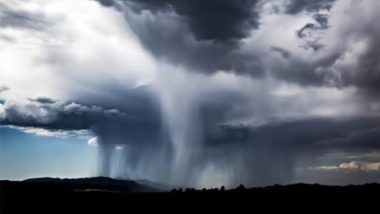New Delhi, August 3: The government is "seized of the matter" related to frequent cloudbursts in the hilly regions of the country due to climate change effect, but there is no established study for India estimating its quantified contribution in triggering such phenomenon, the Parliament was told on Monday.
"Manifestations of extreme events, including cloudbursts, and their incidence are modelled and projected in various scientific assessments. However, there is no established study for India estimating the quantified contribution of climate change in triggering such cloudbursts.
"The science of the attribution of such extreme events to climate change is far more complex and currently an evolving subject and being closely studied by Ministry of Earth Sciences, through the Indian Institute of Tropical Meteorology and the India Meteorological Department," Minister of State for Environment, Forests and Climate Change Ashwini Kumar Choubey told Rajya Sabha member A. Vijaykumar in a written reply.
Listing some of the actions taken to minimise environmental damage due to the occurrence of such natural disasters in hilly areas, he said that the network of meteorological observations including weather stations and Doppler radars are being strengthened for better forecasting of extreme events through the IMD and the IITM.
The National Disaster Management Authority and the State Disaster Management Authority work in close association with the local administration to address the impact of a given disaster by issuing alerts/warnings, and guidelines from time to time to the local communities for response during extreme rainfall/cloudburst events, the Ministefr said.
"The Indian Space Research Organisation has developed a model called NowCasting of Extreme orographic Rain fall events (NETRA) which is currently being used to provide real time cloudburst potential alerts over Uttarakhand, Himachal Pradesh and surrounding regions through MOSDAC web portal (www.mosdac.gov.in). This is done by using satellite thermal infrared data from geostationary satellites along with pre-identified vulnerable locations for cloudburst using historical data," he said.
Under the National Mission for Sustaining the Himalayan Ecosystem (NMSHE), State Climate Change Cell/Centre have been established in each of the Himalayan states which have the mandate of providing assistance to states to take up vulnerability and risk assessment, human capacity building programmes, public awareness programmes, and institutional capacity building to address the sustainability of the Himalayan ecosystem. They also assist in the implementation of actions selected for sustainable development by the States as part of their State Action Plans on Climate Change (SAPCC), Choubey added.
(The above story first appeared on LatestLY on Aug 03, 2021 11:22 AM IST. For more news and updates on politics, world, sports, entertainment and lifestyle, log on to our website latestly.com).













 Quickly
Quickly












